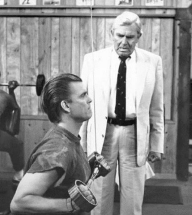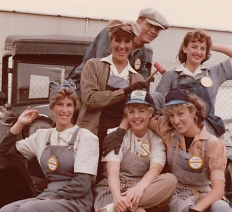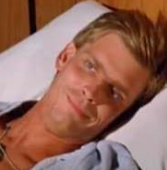ALAN TOY: Polio Survivor, Stage and Film Actor, Advocate for the Disabled
Written by Helen Urban
Alan, age 3
If you were one of the 5.2 million viewers who tuned in to NBC’s “Annie Live!” in December 2021, you are already familiar with polio survivor, Alan Toy who starred as FDR. He joined an A-list ensemble of actors that included Taraji P. Henson and Harry Connick Jr. Alan was the first actor to portray the role of FDR while personally having the same disability. An old wheelchair from a prop company was brought in and rebuilt to make it more historically accurate for Alan to use during his performance. It was an ideal way to bring FDR’s disability into the story line without it overtaking the story. Alan’s polio journey began in 1953 when he was just three years old. He contracted polio while living in Key West with his family while his Dad served in the military. Mostly paralyzed from the waist down, he was transported to Miami Children’s Hospital which at that time, handled most of Florida’s pediatric polio cases. Alan’s few memories of his early days in the hospital include being in a small dark room while he battled the fever, struggling for his life. Then, later he remembers lying on a gurney next to an iron lung - although he was never in one. It was a very scary experience for a three-year-old. He also remembers therapy sessions where, he had to lie on his stomach to work his back and buttocks muscles. He had to lift himself up to look up at a picture of a duck billed platypus on the wall. As a result, he learned quite a lot about that particular animal at an early age!
After months in the hospital, the little boy left with crutches and braces. He eventually worked his way out of one of the braces and has used crutches and a brace most of his life. In recent years he has shifted to using a Firefly battery-operated power mobility attachment.
Alan became comfortable being in the spotlight at a very young age. He participated in multiple fundraisers for polio and was the “cute little blond kid “sitting in the back of the convertible in the March of Dimes parades. (President Franklin Delano Roosevelt started the National Foundation for Infantile Paralysis which later became the March of Dimes). The President asked people to collect and send in their dimes to the White House in support of polio vaccine research and hoped it would lead to the eventual eradication of the disease. Fast forward to December, 2021 and that cute little boy in the back of the Cadillac is on national television playing the role of the man who started the March of Dimes!
When Alan was six, his father was transferred to an Air Force Base in England. While in his new English school, both his mother and teachers greatly encouraged and challenged him to participate in all activities. The teachers encouraged him so much that they even added a wheel barrel race at the end-of-year field day so he could compete in a race by using his arms. He has very fond memories of his time living in the UK.
The family’s next move was to Norfolk, Virginia. After two years, his father retired from the Navy and moved his family to Winston-Salem, NC. While they were living in Winston-Salem, his mother became involved in the Winston-Salem Little Theater and young Alan helped out, mostly doing sound effects. This was his first exposure to the stage. While at Reynolds High, one of his teachers encouraged the students to get extra credit by volunteering in the community arts. Alan volunteered at UNC School of the Arts as an usher and worked the front of the house during productions. Planning to study political science, he met people there who helped influence his decision to pursue a career in the arts. He graduated from Reynolds High School in 1968 and has stayed active with his high school alumni.
Alan loved the theatre and applied to the UNC School of the Arts. He was admitted and studied drama from 1969-1971. He feels that moving and living in several different places gave him a broader experience and exposure to people he would not have otherwise encountered. This resulted in helping shape his outgoing personality and his positive outlook on things. Alan always knew deep down that because he walked with crutches and a brace his acting opportunities would be limited. He was drawn towards directing and enrolled in the Goodman School of Drama in Chicago. His dislike of the cold and Chicago weather didn’t mix. Alan transferred to the California Institute of the Arts in 1972 and found that the weather was much more appealing. He’s never looked back and California has been his base ever since.
Alan & Theresa Toy
Alan met his future wife Theresa, at the Media Access Awards held in Los Angeles. She was an actress, and unfortunately for the couple was based in New York City. After a 10 month bi-coastal romance Theresa moved out to California, where they were married in 1984. Their son John Henry, was born in 1991 while Theresa was pursuing a degree from the UCLA School of Social Welfare.
Although he was having some success, at that time actors with disabilities rarely got many jobs. While on the UCLA campus visiting Theresa with their young son, Alan discovered the UCLA Graduate School of Architecture and Urban Planning. This piqued his interest. In 1992 Alan received a one year Community Scholars fellowship to study there. Once he completed that year he enrolled in the program and earned a Master’s Degree in Urban Planning. Ironically, it was during this period of time when he was in school that many of his more prominent acting jobs presented themselves. He managed to take a few days here and there to work at his acting gigs and still not miss much class time. Alan feels that going back to school and getting his Masters was the best thing since it opened up so many more opportunities for him.
His social activism was sparked by a chance meeting with Frank Sinatra in 1969. While visiting a friend in Connecticut, he went to hang out at the local marina. A huge yacht pulled in and Alan spotted Frank Sinatra on board. His amazed reaction amused Sinatra, and so he invited the young man on board. During lunch, Sinatra was happy to hear that Alan was about to pursue a career in the arts. When Alan left, Sinatra gave him three $100 bills. But the gift had strings attached. He asked that Alan accept the money with the condition that when he himself became successful in the arts, he should do the same for someone in his position and somehow pay it forward. Alan accepted Frank’s challenge and has repaid that obligation many times over by advocating for and supporting those who are struggling to find their place in the world.
Alan Toy and Justin Dart “the Godfather of the ADA” - Outside the White House in 1996
That advocacy was evident in his efforts to lobby the entertainment industry to create characters, storylines, and images that would depict people with disabilities in a more positive light. At the same time, as a member of both the Screen Actors Guild and the American Federation of Television and Radio Artists, Alan worked to make sure that the language in the union contracts included people with disabilities as part of the “protected groups.“
Alan has not limited himself to working with other people to bring about change. He was tired of the negative stereotypical portrayals of people with disabilities. While he was president of the Media Access Office in Hollywood, he was persistent in lobbying the entertainment industry to create characters, storylines and images that would depict people with disabilities in a more positive light. He also helped create and co-chaired the first Inter-guild Committee of Performers with Disabilities.
Alan Toy as FDR.
Source: 2021 NBC Universal Media LLC
Alan has held various positions through the years which involved advocating for disability rights and community-based Independent living opportunities that included bringing more disability inclusion to the work of the ACLU. He has served on many local and state committees and boards. At UCLA, he developed the LILA website (Living Independently in Los Angeles) which assisted people with their day-to-day independent living needs. His last position was director of a Los Angeles Independent Living Center, working to improve housing options, accessible public transit, and homecare for those who would otherwise have to live in nursing facilities. He has given many speeches about Independent Living, and recently spoke to a Rotary convention about the importance of vaccines and the need to eradicate polio worldwide.
Alan’s disability did not stop him from being able to act in both television and movies. His career was highlighted by his opportunity to play a wide assortment of characters including parents, lawyers, doctors, scientist, veterans, teachers, and even a wheelchair using mountain climber. Some of his most well-known TV roles have been in “Beverly Hills, 90210,” “Trauma Center,“ and guest spots on ”Matlock,” “Highway to Heaven,“ and “M*A*S*H.” He has had parts in film such as “The Aviator,“ with Leonardo DiCaprio, “Kansas,“ with Matt Dillon, and “In The Line of Fire,“ with Clint Eastwood. His advocacy has helped many other disabled performers become successful as well, giving audiences new perspectives on viewing people with disabilities.
Now retired, Alan lives in Santa Monica with his wife, Theresa, where he enjoys the beautiful weather year round. He has done some extensive travelling and is occasionally drawn back into advocacy, public service and consulting. No doubt, we haven’t seen or heard the last from Alan Toy!
Alan’s life changed forever when he had polio. Even so, he is thriving in his acceptance of his disability and living his life filled with love for his family and in serving others.









